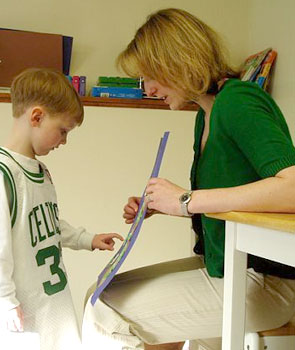Lannon Twomey Speech Therapy - Parents: Home Practice

As parents, you are your child's best teacher. Providing on-going intervention including speech and language modeling promotes generalization of targeted speech and language objectives from therapy into spontaneous language and conversational speech. Provided here are some opportunities for home practice.
Facilitating Language Development at Home
Please refer to the following list for ways you can facilitate language development at home including:
- Reinforce concepts and sounds targeted in therapy sessions.
- Review and use materials created in therapy.
- Read together and talk about what you read.
- Chat about everything you do and see.
- Give your child time to talk before jumping in and answering for him or her.
- Vocabulary is everywhere! Highlight vocabulary when you encounter it.
These documents contain additional information related to facilitating language development at home.
Speech Sound Practice
When your child is ready, home practice is an essential component to improving carryover of speech sounds targeted in therapy. It is important that home practice be a consistent and routine element of the therapy plan for remediation of deviant sounds. When children engage in home activities it is crucial they have the opportunity to practice accurate, appropriate repetitions of target sounds. As Daniel Ling has reminded us…
Practice Doesn't Make Perfect, Practice Makes Permanent!
With a focus on particular sounds or groups of sounds, the following activities can be used as fun ways to practice targeted speech sounds using sound cards (provided when appropriate) based on your child's specific speech production needs. As a general rule, ten minutes of home practice daily is recommended.
Strive for 50 or more accurate sound repetitions during home practice. For information on placement and cueing strategies for speech sounds refer to Multisensory Speech Production Cues, however Lannon will provide specific information about which cues work best for you child.
Books for Articulation Practice
Reading books with your child is a wonderful way to foster language and literacy development as well as practice speech production. This list includes a number of children's books organized by sound. Many include repetitive language including words with a target sound. While reading, pause to allow your child to complete the sentence or phrase using the sound appropriately or ask your child to repeat the target word by asking a question after reading the page. For example, Mom: "What did the brown bear see?" Child: "He saw a green frog."
In addition to the activities provided here, online games, activities and interactive sites are available. Click here to access online speech and language activities.
Using provided articulation cards, select 4–10 pairs of words and place them face down on the table. Take turns choosing two cards and saying each word when revealed. When a match is made, remove the match from the cards in play and continue until all cards have been selected.
Choose 3–5 cards and lean them against the wall or against a book. Use a pencil to hit the coin and try to knock over a card. When a card falls, practice the word five times repeatedly.
Use 6–12 pairs of articulation cards to play this classic card game. Shuffle the cards and pass out 2-3 cards to each player. Put the remaining cards in a pile in the center of the table. Take turns asking, "Do you have a …?" to make matches. If the answer is, "no", the person must, 'go fish' and choose a card from the center pile. Play continues until all cards are matched.
Use one card at a time and hide it around the room. Take turns searching for the card (make it extra fun by using a flashlight to locate it) and state where the card was for example, "The star was under the chair."
Place nine articulation cards in the Tic-Tac-Toe grid. Using two different tokens (such as pennies and dimes) place one token on a square while saying the target word 3-5 times each or create an interesting sentence using the word.
Pair repetitive movements such as clapping, jumping, running, twisting, crab walking, hopping on one foot, stomping feet, etc. with repetitions of a target word. Strive for your child to repeat the word 10 times while maintaining the movement.
